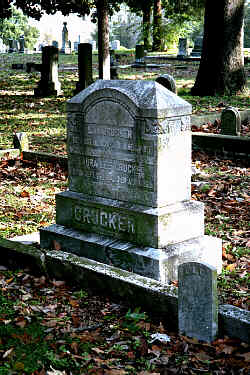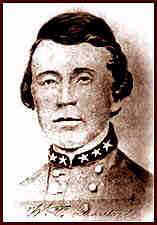 but local amateur scholars have been trying to prove for decades that the bones beneath belong to feared Confederate partisan cavalry commander William Clarke Quantrell, or if you prefer, Quantrill (po-tay-to, po-tah-to).
but local amateur scholars have been trying to prove for decades that the bones beneath belong to feared Confederate partisan cavalry commander William Clarke Quantrell, or if you prefer, Quantrill (po-tay-to, po-tah-to).The name on this stone in this Augusta cemetery is L. J. Crocker,  but local amateur scholars have been trying to prove for decades that the bones beneath belong to feared Confederate partisan cavalry commander William Clarke Quantrell, or if you prefer, Quantrill (po-tay-to, po-tah-to).
but local amateur scholars have been trying to prove for decades that the bones beneath belong to feared Confederate partisan cavalry commander William Clarke Quantrell, or if you prefer, Quantrill (po-tay-to, po-tah-to).
Those familiar with Quantrell's exploits believe him to be either an heroic freedom fighter or a war criminal, depending largely on which side of the Mason-Dixon you were born. I'm as southern as the next guy, but Quantrell's men rounded up noncombatant civilians and shot them dead. No matter where your loyalties lie, you have to recognize that as one heavy stack of bad karma. He and his band weren't generally beholden to any superior military authority, so arguably he might not properly be called a "war" criminal, although the word "criminal" can't be avoided.
Various historians and armchair psychoanalysts have tried to generate twentieth century motives for Quantrell's nineteenth century actions. I'm staying away from that argument. I'm just concerning this article with the question of whether Quantrell's bones might lie under Crocker's stone.
The conventional  history is that Quantrell and a handful of his band were cornered by Union troops and were captured in a shootout in Kentucky and that Quantrell himself died of his wounds in a Louisville hospital. Pretty much every credentialled scholar you consult will tell you that he has heard tall tales of a daring escape by Quantrell, but that those stories are apocryphal and that Quantrell died as a Union prisoner just like the official records say. Revisionist historians pin their hopes on the fact that none of the men captured ever admitted being Quantrell. Perhaps, they theorize, Quantrell had somehow slipped away and that the Union boys listed one of the dead as Quantrell for reasons ranging from carelessness to career advancement.
history is that Quantrell and a handful of his band were cornered by Union troops and were captured in a shootout in Kentucky and that Quantrell himself died of his wounds in a Louisville hospital. Pretty much every credentialled scholar you consult will tell you that he has heard tall tales of a daring escape by Quantrell, but that those stories are apocryphal and that Quantrell died as a Union prisoner just like the official records say. Revisionist historians pin their hopes on the fact that none of the men captured ever admitted being Quantrell. Perhaps, they theorize, Quantrell had somehow slipped away and that the Union boys listed one of the dead as Quantrell for reasons ranging from carelessness to career advancement.
The real drama (and real imagination) comes from some of Quantrell's hypothetical escape scenarios. The most complicated of these requires Kate Clarke to pose as Quantrell's wife to visit him in the hospital, put her dress on him while she takes the clothes of a dead man in the cot next to her husband's. Quantrell's clothes go on the dead man and then he ties his wife up in his cot. He then walks out of the hospital dressed in his wife's clothes. Once the wife is discovered tied up in the cot, she claims that a wounded confederate soldier took her clothes and tied her up in the cot and then she identifies the dead soldier in the next cot as her husband. They fill out the paperwork verifying Quantrell's death and bingo, Quantrell has escaped.
Rule of thumb: more complicated--less believable. I'm not saying it didn't happen that way. I'm just saying that this plan requires Quantrell to be left together in a semiprivate cell unguarded long enough for three people (one of which is dead and therefore not cooperating) to change clothes. In addition to that, the switcheroo requires that the Mrs. know beforehand that there will be a dead soldier from Quantrell's band in the cot next to her husband -- either that or Quantrell was willing to kill one of his own to cover his escape. Finally, when the lady is discovered tied up in the cot, how dumb do the guards have to be to believe the story she is about to tell them?
More likely escape scenarios have Quantrell slipping away during the shootout or being momentarily absent when the Union soldiers close in.
As for Crocker being Quantrell, there's a pile of eyewitness accounts and hearsay confessions. There are some eyebrow-raising verifiable (or falsifiable) facts presented, too. Crocker's wife was the sister of Cole Younger of the outlaw Younger Brothers, who rode with Quantrell's band and who occasionally visited Crocker's home in Woodruff county. Other frequent visitors were Frank and Jesse James, also formerly of Quantrell's band. Crocker was said to have always worn a glove on his left hand, a glove that would have concealed wounds Quantrell was known to have. He is also said to have been missing his right index finger. Quantrell is supposed to have lost his right index finger.
There are also some purported eyeball identifications by bona fide former members of Quantrell's band. Unfortunately, these also fall into the category of hearsay, since they were reported to historians by secondhand sources.
Above all, the revisionists point to the "Masonic Confessions." Crocker is said to have confessed in a lodge meeting his true identity on the condition that his identity was not to be revealed until after his death. A trusted brother supposedly committed a detailed account to paper for later reference and for future historical verification, but the document was destroyed in a warehouse fire. Upon Crocker's death the trusted brother (Senator W. E. Ferguson) recounted what he could from memory--primarily the admission that Crocker was Quantrell.
Too bad about that document. It could have given details that could have lent credibility the Masonic Confession. More than that, the thing that bothers me about the Masonic Confession is that the masons swear oaths that they will protect one another's secrets. Any testimony by one mason concerning another has to be viewed with that in mind.
Conclusion: Crocker thus far not proven to be Quantrell.
The other day I got a call from a scholar in Beebe who says he heard that I was looking up material on Quantrell and he tells me that he has the goods. He has proof positive that Crocker was Quantrell. He sounds like he's been doing a lot of work on the project. He has a good deal of material I've never heard of, handwriting samples and so on. If he's got the proof he says he has, there's considerable history to be rewritten.
One tantalizing quote attributed to Crocker went like this, "There is no such man as Quantrell. I'm as much Quantrell as anyone." Is it possible that Quantrell was an identity assumed by one or another of the band as a matter of convenience when an apparent leader was needed, much as the fictional pirate Captain Roberts in "The Princess Bride?" That could explain a lot of things. For instance, one researcher notes that the outlaw Quantrell, who was very active in the Bloody Kansas period, dropped off the criminal map for the two whole years prior to the Civil War.
Could be the real Quantrell died before the Civil War and this band of partisan outlaws appropriated his identity to generate terror in the countryside. Then at the end of the war, Quantrell vanished because he never was there in the first place. The members of the band were glad to maintain the Quantrell fiction because the authorities had somebody on which to blame the massacres. If Quantrell were discovered to be a fiction, then the members of the band would have been held individually responsible.
Then there is the possibility that the real Quantrell, in order to evade prosecution, assumed the name of L. C. Crocker of company K, 5th regiment of Missouri Cavalry, CSA, a man he knew to have been killed in battle and who had a spotless service record.
As likely as any of the other stories.
So what kind of evidence would definitely connect Crocker and Quantrell? Handwriting samples would be nice. Photographs would be nice. I suppose there could be some kind of DNA comparison between the Crocker descendants and verifiable relatives of Henry Volney Burgess (the supposed birth name of Quantrell). The point is that real proof is going to be just about impossible to get. These guys changed their names more often than their socks and all their stories conflict and many of the stories are related secondhand. There are no military records for partisans, and how reliable are the tales of outlaws recounted by firelight for the entertainment of friends and family?
Still, the guy in Beebe says he's got the goods. Stay tuned.
RTJ--5/1/99
I got another call from David Kennedy in Beebe. He said it would be okay with him if I put his e-mail address on this page, so you Civil War historians can correspond directly with him. Here they are: quantrill.research@mail.usa.com and dkennedy70@hotmail.com
References:
Fitzhugh, Davis. Woodruff County Historical Society; vol. II, #4, pp 2-7.
Smith, Anne Sanderson. The Man Who Played Quantrell, Woodruff County Historical Society; The Man Who Played Quantrell.vol VI #2, pp 2-13.
Dear Mr. Russ:
My name is Reina Quantrell-Gates and I grew up being told we were related to the infamous Raider of the Civil War. My Father, a self proclaimed expert on the Civil War, told us many stories, those of which I have never seen in any given account.
Here are a few tidbits that might interest you. The "family story" is one of my fathers'fathers mother living in Brooklyn around 1910. There was an elderly gentleman whom relative just referred to as the "old man". The unspoken belief was that it was a very aged William Clarke, himself, He is buried in Brooklyn Cemetary and resided with Lena Quantrell, (my great Aunt) and Mr. Frederick Page, my Grandfathers, stepfather.
On a less conclusive note, the farthest I have gone back was my Father's Grandfather, Thomas Quantrell who died about 1870-75. My grandfather was only 8, had to quit school to support his mother and two sisters. He later became an Editor at the New York Daily Record. Wrote under the name of "Kew."
My brother and I would be willing to donate blood for DNA testing, Hope to hear from you.
Sincerely,
Reina
Your Host responds: Reina's e-mail address is reina@psln.com. No way am I going to fund DNA testing myself. Very expensive. Look how much trouble it was to get that Jefferson-Hemmings thing done.
UPDATE 3/22/2000